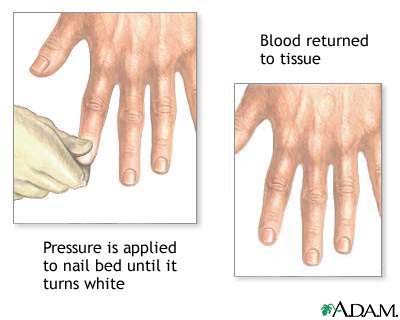Health Library
Capillary nail refill test
Nail blanch test; Capillary refill time
The capillary nail refill test is a quick test done on the nail beds. It is used to monitor dehydration and the amount of blood flow to tissue.
Images

I Would Like to Learn About:
How the Test is Performed
Pressure is applied to the nail bed until it turns white. This indicates that the blood has been forced from the tissue under the nail. It is called blanching. Once the tissue has blanched, pressure is removed.
While the person holds their hand above their heart, the health care provider measures the time it takes for blood to return to the tissue. Return of blood is indicated by the nail turning back to a pink color.
How to Prepare for the Test
Remove colored nail polish before this test.
How the Test will Feel
There will be minor pressure to the bed of your nail. This should not cause discomfort.
Why the Test is Performed
Tissues need oxygen to survive. Oxygen is carried to various parts of the body by the blood (vascular) system.
This test measures how well the vascular system works in your hands and feet -- the parts of your body that are farthest from the heart.
Normal Results
If there is good blood flow to the nail bed, a pink color should return in less than 2 seconds after pressure is removed.
What Abnormal Results Mean
Blanch times that are greater than 2 seconds may indicate:
- Dehydration
- Hypothermia
- Low blood pressure
- Peripheral vascular disease (PVD)
- Shock
Related Information
DehydrationShock
Peripheral artery disease - legs
Hypothermia
References
McGrath JL, Bachmann DJ. Vital signs measurement. In: Roberts JR, Custalow CB, Thomsen TW, eds. Roberts and Hedges' Clinical Procedures in Emergency Medicine and Acute Care. 7th ed. Philadelphia, PA: Elsevier; 2019:chap 1.
Schoener B, Wagner MJ. Hand injuries. In: Walls RM, ed. Rosen's Emergency Medicine: Concepts and Clinical Practice. 10th ed. Philadelphia, PA: Elsevier; 2023:chap 42.
Swartz MH. The peripheral vascular system. In: Swartz MH, ed. Textbook of Physical Diagnosis: History and Examination. 8th ed. Philadelphia, PA: Elsevier; 2021:chap 15.
BACK TO TOPReview Date: 6/20/2023
Reviewed By: Jacob Berman, MD, MPH, Clinical Assistant Professor of Medicine, Division of General Internal Medicine, University of Washington School of Medicine, Seattle, WA. Also reviewed by David C. Dugdale, MD, Medical Director, Brenda Conaway, Editorial Director, and the A.D.A.M. Editorial team.
 | A.D.A.M., Inc. is accredited by URAC, for Health Content Provider (www.urac.org). URAC's accreditation program is an independent audit to verify that A.D.A.M. follows rigorous standards of quality and accountability. A.D.A.M. is among the first to achieve this important distinction for online health information and services. Learn more about A.D.A.M.'s editorial policy, editorial process and privacy policy. A.D.A.M. is also a founding member of Hi-Ethics. This site complies with the HONcode standard for trustworthy health information: verify here. |
The information provided herein should not be used during any medical emergency or for the diagnosis or treatment of any medical condition. A licensed medical professional should be consulted for diagnosis and treatment of any and all medical conditions. Links to other sites are provided for information only -- they do not constitute endorsements of those other sites. No warranty of any kind, either expressed or implied, is made as to the accuracy, reliability, timeliness, or correctness of any translations made by a third-party service of the information provided herein into any other language. © 1997- 2025 A.D.A.M., a business unit of Ebix, Inc. Any duplication or distribution of the information contained herein is strictly prohibited.
